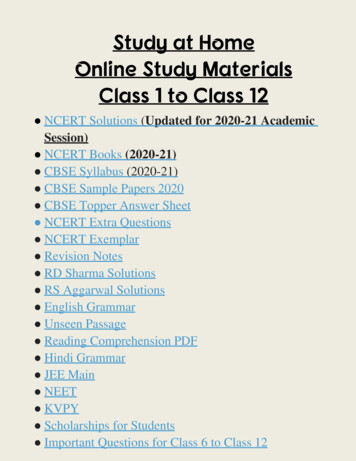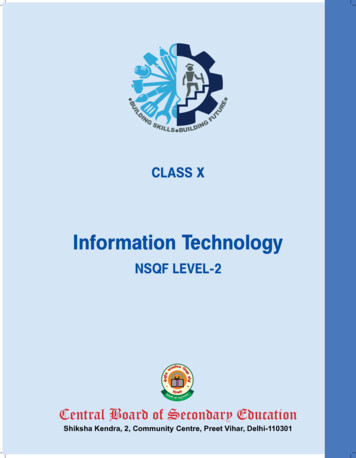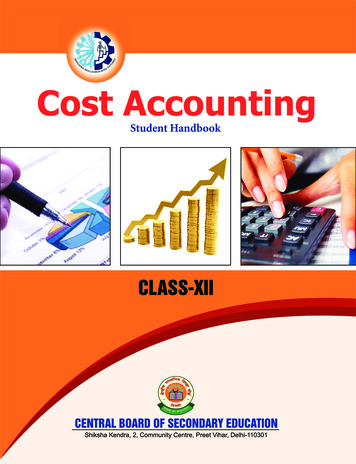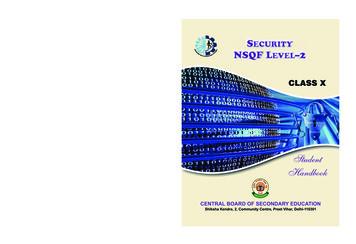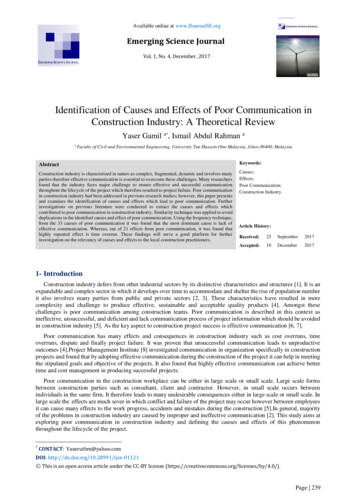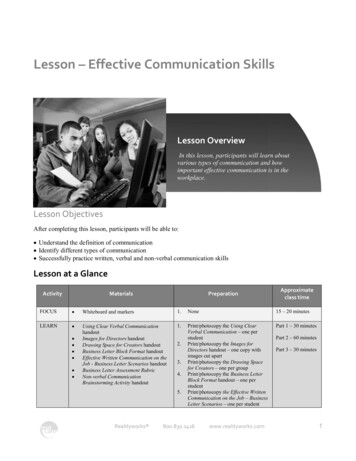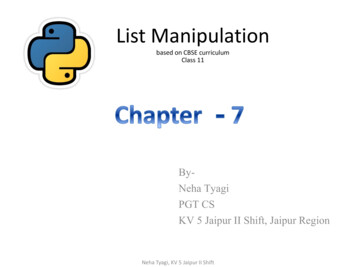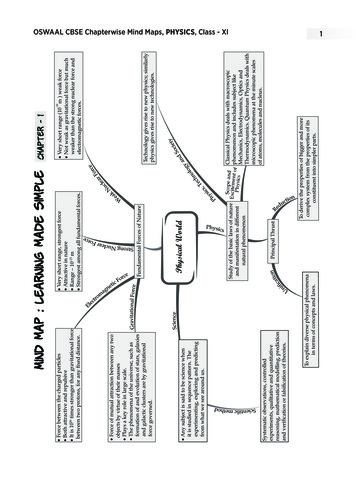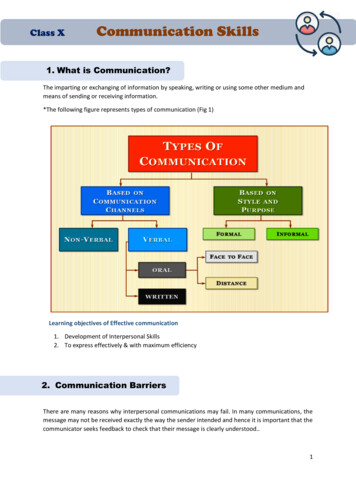
Transcription
Class XCommunication Skills1. What is Communication?The imparting or exchanging of information by speaking, writing or using some other medium andmeans of sending or receiving information.*The following figure represents types of communication (Fig 1)Learning objectives of Effective communication1. Development of Interpersonal Skills2. To express effectively & with maximum efficiency2. Communication BarriersThere are many reasons why interpersonal communications may fail. In many communications, themessage may not be received exactly the way the sender intended and hence it is important that thecommunicator seeks feedback to check that their message is clearly understood.1
2.1 Overcoming BarriersMost of the above mentioned barriers can be overcome by the skilled communicator. Obviously,bridging gaps in geography and communicating through disabilities are a topic for a differentdiscussion. Below, we will look at some tools that can be used to bridge barriers in everydaycommunications.2.2 Active ListeningActive listening is a skill that can be acquired and developed with practice. 'Active listening' means,,actively listening. That is fully concentrating on what is being said rather than just ‘hearing’ themessage of the speaker. Active listening involves listening with all senses.2.3 Use Simple LanguageIt’s important to remember the audience that you’re speaking to, and use language that can be easilyunderstood.2.4 Give Constructive FeedbackFeedback is part of the communication cycle. While the feedback that we give the speaker/sendermay occasionally be negative, it is important that it be constructive in nature.2.5 SummaryAs living beings, we need to express and understand the expressions of others. Like it or not, humansociety thrives on communication. Civilizations have risen and fallen based upon how good they wereat maintaining sound relations with the rest of the world.2
3. FeedbackFeedbackisaconsequenceofperformance. Feedback plays an importantpart in communication because it tells boththe source and the receiver, how theirmessage are being interpreted. .3.1 Descriptive feedback is specificinformation, in the form of writtencomments or verbal conversations, that help the learner understand what she or he needs to do inorder to improve. Descriptive feedback is the most powerful tool for improving student learning.https://www.youtube.com/watch?v PoFm5a6lWqMThe above link will help the students know more about Descriptive feedback.3
3.2 Specific Feedback provides detailed or specific information on what the student did well or notso well.3.3 General feedback on the other hand is very non-specific, such as “good job” or “you did great.”Types of Feedback( Activity )Directions: Decide which of the two types of feedback is represented by the statements below. Write a Dfor Descriptive and S for Specific feedback. If the feedback statement is Descriptive, discuss how thelanguage might be revised to enhance its effectiveness.S.noStatement1.2.Try harder next time.You maintained eye contact throughout your entire Speech; now you might workon your enunciation.You solved the equation; however, you need to include a written or visualexplanation.You made some simple mistakes on your timeline. Make sure that your timeintervals are all the same length.Your writing has definitely improved.You made some errors on your graph. Go back and check the names of your title, xaxis, and y-axis.89%! B ! Good work! I am proud of you. You should be thrilled with your progress.You are so close to proficiency. With a little more work, you should be at a level 3.Your topic sentence is clear; your next step might be to add concrete details tosupport it.Messy!3.4.5.6.7.8.9.10.Descriptiveor Specific4
4. 7 C’s of CommunicationThere are 7’cs of communication which are applicable to both written as well as oral communication.These are as follows4.1.Completeness - The communication must be com. It should convey all facts required by theaudience. The sender of the message must take into consideration the receiver’s mind set and conveythe message accordingly. A complete communication has following features: Complete communication develops and enhances reputation of an organization.A complete communication always gives additional information wherever required. Itleaves no questions in the mind of receiver.Complete communication helps in better decision-making by theaudience/readers/receivers of message as they get all desired and crucialinformation.It persuades the audience.4.2 Conciseness means wordiness, i.e, communicating what you want to convey in least possiblewords without forgoing the other C’s of communication. Conciseness is a necessity for effectivecommunication. Concise communication has following features: It is both time-saving as well as cost-saving. It underlines and highlights the main message as it avoids using excessive andneedless words. Concise communication provides short and essential message in limited words to theaudience. Concise message is more appealing and comprehensible to the audience.4.3.Consideration - Consideration implies “stepping into the shoes of others”. Ensure that the selfrespect of the audience is maintained and their emotions are not at harm. Modify your words inmessage to suit the audience’s needs.5
4.4.Clarity - Clarity implies emphasizing on a specific message or goal at a time, rather thantrying to achieve too much at once. Clarity in communication has following features:It makes understanding easier.Complete clarity of thoughts and ideas enhances the meaning of message.4.5.Concreteness - Concrete communication implies being particular and and clear ratherthan fuzzy and general. Concreteness strengthens the confidence. Concrete message hasfollowing features: It is supported with specific facts and figures. It makes use of words that are clear and that build the reputation. Concrete messages are not misinterpreted.4.6.Courtesy - Courtesy in message implies the message should show the sender’sexpression as well as should respect the receiver. The sender of the message should besincerely polite, judicious, reflective and enthusiastic. Courteous message has followingfeatures:4.7. Correctness - Correctness in communication implies that there are no grammaticalerrors in communication. Correct communication has following features: The message is exact, correct and well-timed. If the communication is correct, it boosts up the confidence level. Correct message has greater impact on the audience/readers. It checks for the precision and accurateness of facts and figures used in the message. It makes use of appropriate and correct language in the message.Awareness of these 7 C’s of communication makes us an effective communicator.1.Constructing sentences that convey all facts required by the receiver - ActivityFor an example of poor communicating skills, look at this email below.Bad example:Dear ArjunI would like to talk to you about the new client’s project which the engineering team had discussedyesterday. I might need the help of Raghav from your team.RegardsMohitThere are innumerable things that are wrong in this email. Arjun might not even know who the newclient is or what the project is about. He probably was not part of the meeting with the engineeringteam. Furthermore, there might be more than one Raghav’s in Arjun’s big team. Mohit also mentionsthat he wants to talk. However, he hasn’t mentioned what time he would like to talk, neither has heasked Arjun if he would be free at any of the time slots available.6
Expressing in a manner that shows respect to the receiver of the messagePolite requests are useful for setting people at ease and still getting the assistance you need.ACTIVITYCareer HelpStudents will work together to brainstorm a list of as many occupations as they can. Once theyhave completed their list, have the two students write a dialogue which includes as manyrequests as possible. Each dialogue should feature one of the careers they listed in theirbrainstorming session and should use a variety of methods for making polite requests.ExerciseBooking an appointment with DoctorI would like to bookI cant make itThat works for meCan I haveWould you like me toDo you mindUse the above phrases to fill in the blanks of the conversation ( Telephonic)A: Max hospital Medical sevices,Annie Speaking. How may I help you?B: Good afternoon. Appointment with Dr Rastogi for next week?Preferably on Thursday morning.A; Let me check the schedule next week. Well, I am sorry. I am afraid he won’t in thehospital on Thursday morning but he has an opening in afternoon at 3.00pm. book an appointment at 3.00 pm?B:No , . I work full time. So it has to be either in the morning or evening.What about Friday at 8.30 am?A: He will be busy at that time. But he has an opening at 9.15 am.B: Great !7
5. Communication GamesCommunication games are a fun way for the students to learn helpful methods through teaminteraction.Games5.1 Card PiecesCard Pieces helps build negotiation skills and empathy, which are key components ofeffective communication.What students need? Nine or more studentsPlaying cards cut into triangles (to make your pieces, cut the cards diagonallyand then diagonally again)EnvelopesSeparate groups of three or four people into at least three teams. Each team will receivean envelope of mixed cut up playing cards. The teams then have 8 to 10 minutes to barterand trade pieces in order to complete their cards. The team with the most completed cardswins. This game works well because it helps student hone their negotiation skills to achievethe most successful outcomes.5.2.Blindfold GameBlindfold Game builds trust, listening and instructional skills. Four or more studentsBlindfoldsVarious “obstacles” such as boxes, chairs or booksHow to play:Construct an obstacle course with your various items. Divide your players into teams oftwo. Tie a blindfold on one member and have them stand at the “start” of the obstaclecourse. The second member must then guide the blindfolded member through thecourse by calling out directions. This game encourages cooperation, successful teamworkand trust, which is crucial for effective communication. When there is a lack of trust, itbuilds suspicion and prevents buy-in.6. Basic Writing Skills7.Sentences6.1A sentence is a group of words giving a complete thought. A sentence must contain a subject and averb.8
Simple, compound, and complex sentences6.1.1Simple sentenceA simple sentence is one independent clause that has a subject and a verb and expresses a completethought. Must have a subject and a verb. Must express a complete thought. Must only have one clause.Examples I am out of paper for the printer.Will you help me with the math homework?6.1.2 Compound SentenceA compound sentence allows us to share a lot of information by combining two or more relatedthoughts into one sentence.ExampleI drove to the office, and then I walked to the cabin.6.1.3 Complex sentenceA complex sentence is a sentence that combines one independent clause with at least onedependent clause.Example Although Rohan had some doubts, he found the courses very useful. Computers have come a long way since they first came on the market.Activity- CHIT- CHATThis activity simulates ‘chatting’ – a popular (online) communication can be used in the language-learningclassroom for students who still find it too difficult to write without first having a little ‘thinking’ time, andalso as a means of moving students away from being overly concerned with accuracy, and focussing moreon successful communication.The students will need one piece of paper for writing on simple sentences. To encourage students to writebrief messages each time, this could be in the form of a ‘chatting page.( The activity will be done inpairs)CHAT SHEETStudent AStudent BStudent AStudent B9
6.2 PhrasesPhrases are a group of words that work together tocommunicate an element of speech.The following figure represents the different types ofphrasesActivityThe following activity may help the students to strengthen the concept further:DescriptionWrite phrases on both sides of the card or the paper. Show them only one side and ask them to guess theback side.*To further build up the concept, few worksheets will be given to check how much they have learnt .One of the example is listed belowIdentify the phrase type:1.Houses are [unbelievably expensive] just now.2. We [met Paul] last week3. 3. [A car that won't go] is not particularlyuseful4. I enjoy eating [in Indian restaurants]5. . Don't you have to leave [early]?6. Tell [him] not to worry.Adjective PhraseAdverb PhraseNoun PhrasePrepositonal PhraseVerb PhraseAdjective PhraseAdverb PhraseNoun PhrasePrepositonal PhraseVerb PhraseAdjective PhraseAdverb PhraseNoun PhrasePrepositonal PhraseVerb PhraseAdjective PhraseAdverb PhraseNoun PhrasePrepositonal PhraseVerb PhraseAdjective PhraseAdverb PhraseNoun PhrasePrepositonal PhraseVerb PhraseAdjective PhraseAdverb PhraseNoun PhrasePrepositonal PhraseVerb Phrase10
6.3 Parts of a SentenceEvery sentence can be broken into two partsa) Complete Subjectb) Complete Predicate The complete subject consists of simple subject ( The noun or the pronoun is the subject is about)and its modifiers The complete predicate is made of up of verb and its modifiers.Yesterday after lunch the students were complaining about the short recess.Here we will explore the theme of social media. Students will create an imaginary online 'wall' wherethey can interact with each other.ActivityMaking a Social Networking ProfileNameAgeGenderLocationHometownInterested in(Hobbies)StrengthsWhy I am herePersonalityIntrovert/ExtrovertThis activity will help the students to make contacts, communicate and express themselvesbetter .11
6.4 Parts of speechA category to which a word is assigned in accordance with its syntactic functions. In English the mainparts of speech are noun, pronoun, adjective, determiner, verb, adverb, preposition, conjunction, andinterjection.The following figure represents eight parts of speechThe following link will help to reinforce the concept(https://www.youtube.com/watch?v v9fCKTwytJA)Activity 4Class projects can be an excellent way to focus the whole class and get them workingtogether towards a common goal. Taking some ‘time out' from regular classes and doingsomething completely different can really help group dynamics and you may also givequieter or less able students a chance to shine. Making a class magazine is a project that willappeal to most groups as it allows individuals to work on what interests them.Planning*Bring in some magazines. Let the students have a look through them. The teacher will aclass survey on magazines at this stage or simply converse with the class about the type ofmagazines they like.On the board brainstorm the different sections that magazines have. Try to include as muchvariety as possible so there's something for everyone. (Horoscopes, sports pages, filmreviews, cinema news, fashion, photo stories, comic strips, puzzles, technology pages,music, interviews with famous people, recipes, jokes, problem pages etc. etc.) Making aclass magazine should be an enjoyable experience for the students. This will improve theirwriting skills and simultaneously help them to express and know each other better.12
7.Article Writing8.Article writing is the process of creating a non-fiction text about current or recent news, items ofgeneral interest or specific topics.The following figure represents the format of Article writing*The following link will help to build up the concepthttps://youtu.be/q2197KT1iNE?list RDQMaJwsUDCsYv4Activity 5Doing surveys can be a useful way of getting your students to interact, produce questionforms and collect and analyse real information.This survey has been designed for younger learners and is based on the theme of schoolsubjects.PreparationOne class is going to survey a different class that they don't know. Examples of fewquestions which can be asked are listed below1) What’s your favourite subject?2) What’s your worst subject?3) What’s the most important school subject?After a brief discussion, students will write an article highlighting the problems studentsare facing in different subjects and remedial measures on the same. This activity gives themthe chance to practise target language in context and it also prepares them for the surveywith students they may not know.13
7.1 Construction of the ParagraphWhat is a paragraph?A paragraph is a series of sentences that are organized and coherent, and are all related to a singletopic.Activity – A perfect storyThis activity leads students into writing a short story using the past simple, present perfectsimple and continuous, but in a more creative way.This activity aims to help students torecognise their own problems with paragraph construction and to identify errors, whichimproves their own re-drafting skills.1.The students they are going to write a short story.2.The students will read the following questions and decide, with a partner, what themissing words are, but not answer the questions . What is his / her name?a) What is about them? (e.g. strange / unusual / nice.)b) What was their --problem last year?c)What happened?d) Why have they become so ?e) How many have they - ?f) Who have they been recently?g) What have they been for the last five years?This activity aims to help students to recognise their own problems with paragraph( story)construction and to identify errors, which improves their own re-drafting skills14
SummaryA classroom environment relies heavily on the quality of communication taking place within it. As aninstructor, taking steps towards improving the communication skills of your students will contributepositively towards your classroom climate. Students with effective communication skills will be morelikely to contribute to class discussions, will be more productive members in group projects, and willultimately gain more from their experience in the class. Learning and practicing writing skills helpstudents to handle professional and social tensions.References: Google: You tube: British council Library15
16
Class XSelf-Management SkillsStress is one of the important reasons of low productivity in all stages of life. Stress drains one’s energy1. impedesStressandthe day to day work and peace of mind.Stress can be a positive stress, if taken in right sense and may help in achieving effective outcomes.But, the most common is negative stress that makes a person worrisome, less productive and maylead to various psychosomatic disorders too.2.Meaning and Importance of Stress ManagementStress Management refers to focusing human efforts for maintaining a healthy body and mind capableof better withstanding stressful situations. Occasional stress is an unavoidable part of one’s life. Stressrefers to a “physical, mental, or emotional strain or tension”. Small amounts of stress have a positiveeffect and they help us stretch ourselves to a new level. High levels of stress over prolonged periodsneed to be managed. A Stress well managed can help one view events and situations as challengesand contributes in the growth of individual. Unmanaged stress leads to anxiety and sorrow resultingin ill status of mental and physical health. Stress causal agents can have following origins.2.1 Mental: Students can be left overwhelmed,if they are unable to handle their assignmentsubmission deadlines and examinations grades.High expectations from self can leave one withchronic anxiety and stress.Mental2.2 Physical: As children grow up, they maySTRESSCAUSALAGENTSseek more independence, may become criticallyconscious of their looks and have to cope up withhormonal changes. Issues related to generalwell-being and health of an individual can lead tolow self-esteem and cause stress.2.3 Social : Discord amongst family members,peer pressure for doing things which childrenwould generally avoid , maintaining balance inrelationships amongst friends, status show offmay lead to stress at times.PhysicalSocialFINANCIALFig. 1 Stress Causal Agents’2.4 Financial: Youngsters may have aspirational financial stress. This may be of becoming financiallyindependent.17
3. Importance of StressManagementBeing well versed with stress coping mechanisms helps people lead healthy and happier life.Adequately managed stress prevents medical and physical illnesses. Stress management is vitalbecause it leads to following benefits: Improves moodBoosts immune systemPromotes longevityLeads to burst of physical strength, which is vital for reaching goalComplete mental and physical engagement for task accomplishmentIncreases efficiency and effectivenessPrevents psychological disorders and behavioral problems4. Stress Management TechniquesStress is a mental state where one size doesn’t fit all, what stresses one person may not stress othersat all. It is highly individualistic phenomenon and the solution has to be customized to individual’smental state. Physical signs which may suggest stress are: breathlessness, dry mouth, butterflies instomach, indigestion, nausea, acidity, fatigue, sweaty palms, cold hands and feet, irritationhyperactivity etc. At the mental level followingsymptoms may reflect stress: irritation, impatience,loneliness, upset mood, anxiety, , depression, ,frustration, boredom, guilt, insecurityandforgetfulness.Self-awareness of symptoms of stress will helpindividuals manage it better. They should tryunderstanding the cause, understanding self andtaking remedial measures. Avoiding the issues orprocrastination is not the solution. Speaking out tothe well-wishers like family and friends helps instress management as they provide a social supportsystem. Apart from positive thinking, managingone’s time across any or a combination of thefollowing activities aid in stress management.4.1 Physical ExerciseWhen stress affects the brain, rest of the body also feels the impact. Physical exercise in theform of walking, skipping or for that matter indulging in any sports has been found to relievestress as they stabilize mood, improve self-esteem and induce sleep.4.2 YogaYoga is a school of Hindu philosophy that reduces stress. Yoga includes a series of posturesand breathing exercises practiced to achieve control of body and mind.18
4.3 MeditationIt is a practice where an individual is supposed to focus his/her mind on a particular object,thought or activity to achieve a calm mental state reducing stress.4.4 EnjoyingRecreational activities like watching movies, attending concerts, playing games, involving inadventure sports, singing, dancing or even sketching can help individuals transcend to ahappier mental state and help manage stress.4.5 Going On Vacations with Family and FriendsVacations provide an opportunity of taking a holiday from our routine and appreciate differentfacets of life. Vacations can be taken up to friends and relatives’ place as well as to far flungattractive locations. Vacationing helps in de-stressing individuals.4.6 Taking Nature WalksTaking nature walks in a pristine environment of a national park or a sanctuary or a trail incountry side / village, brings us a calmness by allowing our over stimulated minds a chance torelax and helps us to relax.5. Self-Reliance - Ability to Work IndependentlyEveryone who has been sent on this earth hasbeen blessed in their own way. They togethermake this earth a beautiful place. Some cansing well, others are good at sports, some areintellectuals and some are good comedians.Everyone is special. But it is important thateveryone learns the art of workingindependently. This typically means that onemust learn to take ownership of the taskassigned and leave no stone unturned inaccomplishing the task. The individual whohas the ability to work independently need notbe supervised for the task completion.5.1 Importance of The Ability to Work IndependentlyFollowing benefits of working independently advocate its importance. Ensures greater learning.Individuals feel more empowered and responsible.It provides flexibility to choose and define working hours and working mechanisms.Failure and success of the task assigned are accounted by individuals.Individuals become assets to organizations, groups and nations at large.It ensures creativity and satisfaction amongst individuals.19
5.2 Enhancing Ability to Work IndependentlyAbility to work independently can be enhanced by being self-aware, self-motivated and selfregulated. Let’s now learn what are these:5.2.1 Self-AwarenessHaving conscious knowledge of your own self, capabilities, feelings and one’s own character is calledas self-awareness. It helps individuals to chart their ways for working independently. They becomeaware of their strengths and weak points and work accordingly. They try to focus on strengths tobecome successful in various arenas of life.5.2.2 Self-MotivationSelf-motivated individuals have an inner urge to do something, achieve their goals without anyexternal pressure/lure for award or appreciation. It is a life skill and must be necessarily developed.5.2.3 Self-RegulationSelf-regulation guides independent individuals as it helps them consider long term consequencesrather than just transient feelings. It leads to a responsible and a value driven behaviour. It teachesself - control and well directed efforts to reach goal. Self – regulation inculcates discipline that helpsin consistent efforts to move towards goal.A 1, A2, A3, A4Lets’ Do It !!Session A. Doing a yoga session/ meditation and discussing with students about their experiences.Session B. Asking students to prepare a write-up/essay on experiences during a holiday trip.Session C. Asking students to present a talk on “what I Wish to become and what I do about it”.Session D. Planning of an activity in groups for creating a plan for school fest/ any event in school/class party and demonstrating how individual members contributed, discuss about the qualitiesrequired for working independently as well as in a team. Try to list out the qualities shown by all teammembers during accomplishment of the task.20
21
ICT SkillsClass XUnit 1. Distinguish between different Operating Systems1.1 Classes of Operating systemsAs we all know that computer is a very useful machine. It is very important to properly start thecomputer and after finishing the work, it needs to be properly shut down. If the power of the computeris switched off, and the files you were working on were not closed, the files and the operating systemmay get corrupted.1.1.1 Operating SystemAn operating system is a software that serves as an interface between the user and the computer.Some of the functions of Operating system are: It manages all the devices of a computer and keeps track of the status of the device, whether it isbusy or not.It also checks whether the device is functioning properly or not.It also controls software resources of the computer.It manages the computer memory and keeps track of which memory space is in use by whichprogram and which space is free.It manages the structure of the files and directories on a computer system.It keeps track of the amount of disk space used by a specific file.It allows you to create, copy, move and delete files.1.1.2 Types of Operating SystemsWe have already discussed about some commonly used operating systems in class IX. These are: DOS (Disk Operating System)Windows It is an operating system developed by Microsoft.Linux It is an operating system designed for personal computers. It is a free and open-sourcesoftware Mobile operating Systems Android Symbian Windows Phone iOSThe different types of operating systems are as follows:Interactive (GUI-based) A graphical user interface is a user-friendly operating system in whichcommands can be entered by clicking/double-clicking/right-clicking a mouse. Windows operatingsystem is an example of an interactive operating system.Single-user , single-task operating system This type of operating system allows only one user to do atask on the computer and one thing at a time.22
Single-user, multi-task operating system This type of operating system is used on Desktop computers,laptops, where a single user can operate on several programs at the same time. For example,Windows, Apple MacOS are examples of single-user multi task operating system.Multi-user A multi-user operating system enables multiple users to work on the same computer atdifferent times or simultaneously.Real Time A real time operating system is used to control machinery, scientific instruments, likerobots, in complex animations and computer controlled automated machines. A real-time operatingsystem is a computing environment that reacts to input within a specific period of time. It managesthe resources of the computer so that any particular operation is executed in the same amount oftime every time it is executed. Windows CE and Lynx OS are examples of real-time operating systems.Distributed A distributed operating system runs on a set of computers that are interconnected by anetwork. It combines the different computers in the network into a single integrated computer andstorage location. Windows, UNIX, and LINUX are examples of distributed operating systems.1.2 Menu, icons, and task bar on the DesktopLet’s discuss about Windows 7 operating system.1.2.1 Windows 7 operating systemWindows 7 is an operating system developed by Microsoft and is used on personal computers.After loading Windows 7, the first screen that appears on the monitor is called desktop. From thedesktop, you can access different components of Windows 7.By default, Windows 7 has a picture for the desktop background. This is called wallpaper.Small pictures on the desktop are
4.7. Correctness - Correctness in communication implies that there are no grammatical errors in communication. Correct communication has following features: The message is exact, correct and well-timed. If the communication is correct, it boosts up the confidence level. Correct message has greater impact on the audience/readers.
